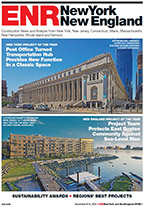The idea of "intrapreneurship"—that is, nurturing the entrepreneurial spirit within big corporations— resonated with attendees of ENR's FutureTech conference, held in San Francisco on March 16-17. Gifford Pinchot III, who coined the term, said the idea is relevant to construction, particularly now as it pushes toward high-performance buildings.
Intrapreneurs exhibit curiosity, often spend free time developing an idea and see the big picture, says Pinchot, author of "Intrapreneuring in Action: A Handbook for Business Innovation." He offers an online program that helps intrapreneurs build business plans and teams and coaches them as projects are launched.
 |
| PINCHOT |
Pinchot gives tips about how to overcome the "organizational immune system that tries to stamp out new ideas." The first step is to "ask for advice, not resources"—it's a question the manager can say yes to. The next step is sincere "gratitude" for the advice. The manager now has contributed to the idea and that makes the idea better in the manager's view.
Pinchot also recommends building a "coalition of sponsors." Managing innovation is not a process, he notes, it's a relationship—between the sponsor who has the power to provide resources and protection and the intrapreneur. Cultivating that relationship is key to enabling intrapreneurship, and supporting managers who turn out to be good sponsors is very important to moving the ideas along, he adds.
David Burns, director of field solutions at McCarthy Building Solutions, says he relates to being a sponsor of intrapreneurs. He recommends starting small and defining how intrapreneurs work, putting an emphasis on communication. "Not knowing creates fear, which creates resistance," he says. Burns advises driving forward with strategic technology investments while supplementing those with the creative innovations happening all across the organization.
Rosana Wong spoke of the intrapreneurial culture at Yau Lee Holdings Ltd., Hong Kong, where she is the executive director. Yau Lee's construction group self-performs everything except piling and specializes in fast-track modular construction and sustainable solutions. The firm "is basically a contractor in the region" but sometimes acts as owner and developer, too, Wong says.
 |
| WONG |
Yau Lee embraced sustainable construction in 2005 to pioneer innovations in materials, methods, equipment and operations. The company benchmarks innovations in its own hotel, the Holiday Inn Express Hong Kong SoHo, against all of the city's other hotels to show that it operates at a 58.5% savings. One key innovation is its proprietary "Powerbox" web-based energy management system, which had a payback period of less than four years. Wong advises, "The best way to predict the future is to invent it."






